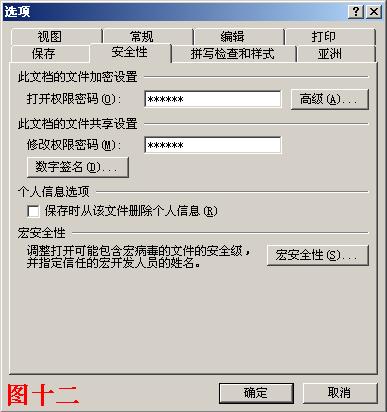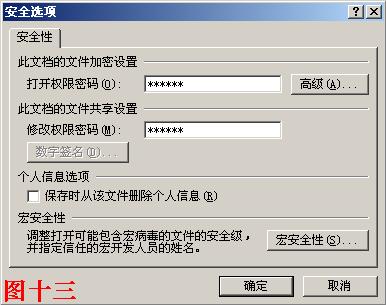Introduction to encryption methods for presentations
How to encrypt a presentation
In order to solve the security problem of the presentation, you can consider encrypting it. This is a new feature in PPT2002 version. Encryption can effectively protect the security of document content and prevent unauthorized persons from viewing or tampering. The specific operation method is to select "File" - "Save As" in the menu bar of PPT2002, then check the "Encrypt Document" option in the pop-up dialog box, and set a strong password. so,
Start PPT2002, open the corresponding presentation, and then choose one of the following two methods to encrypt it:
1. Execute the "Tools → Options" command, open the "Options" dialog box, switch to the "Save" tab, set the password for the corresponding option (see Figure 12), confirm to return, and then save the document. That’s it.

2. Execute the "File → Save As" command to open the "Save As" dialog box. Press the "Tools" button on the upper right side of the dialog box. In the drop-down menu that pops up, select the "Security Options" option and open the " In the Security Options dialog box (Figure 13), set the password for the corresponding option, click OK to return, and then save it with a name.

Tips: ① If the "open permission password" is set, when the user wants to open the corresponding presentation in the future, he must enter the correct password in the dialog box as shown in Figure 14, otherwise it cannot be opened.

If the "modify permission password" is set, when the user opens the corresponding presentation in the future, if the user enters the correct password in the dialog box as shown in Figure 15, not only can the document be opened, but also the document can be modified. If you do not enter the correct password, you can press the "Read Only" button to open the document for playback, but you cannot modify it.

② "Open permission password" and "Modify permission password" can be set the same or different.
③Although we say that the presentations produced by PPT2002 and PPT2000 are compatible with each other, the encrypted PPT2002 presentations are displayed as garbled characters when opened with PPT2000.
How to encrypt office ppt2007
To encrypt files with a password in Word, Excel or PowerPoint, you can first click the Office button in the upper left corner of the Office program window. Select "Prepare > Encrypt Document". Enter a secure password in the password field. It must be at least eight characters long and can use a mix of uppercase and lowercase letters, numbers, and symbols. Enter the same password again when prompted.
You can store files in the format of Office 2007 files (.docx, .xlsx or .pptx), or you can store files in the format of Office 97?D2003 (.doc, .xls or .ppt). You will see a dialog box that advises you that XML format is the most secure, and then asks you if you want to convert to XML file format to enhance the security of the document. Now, when you or someone else opens the file, a dialog box will pop up prompting you for a password.
In addition to setting a password for documents to encrypt them, Office 2007 also allows you to set a file sharing password. The encryption mentioned before refers to the need for a password when opening a document, while the file sharing password requires a password only when modified.
To set a modified password for a file, you need to use the "Tools" in the "Save As" dialog box, which can also be used as another method to set an opening password. In the document, you only need to click the Office button and select "Save As". Then, in the "Save As" dialog box, enter the name of the file, click the down arrow next to "Tools", and then select "General Options" . In the General Options dialog box, you can enter the opening password or change the password.
The above is the detailed content of Introduction to encryption methods for presentations. For more information, please follow other related articles on the PHP Chinese website!

Hot AI Tools

Undresser.AI Undress
AI-powered app for creating realistic nude photos

AI Clothes Remover
Online AI tool for removing clothes from photos.

Undress AI Tool
Undress images for free

Clothoff.io
AI clothes remover

Video Face Swap
Swap faces in any video effortlessly with our completely free AI face swap tool!

Hot Article

Hot Tools

Notepad++7.3.1
Easy-to-use and free code editor

SublimeText3 Chinese version
Chinese version, very easy to use

Zend Studio 13.0.1
Powerful PHP integrated development environment

Dreamweaver CS6
Visual web development tools

SublimeText3 Mac version
God-level code editing software (SublimeText3)

Hot Topics
 How to Create a Timeline Filter in Excel
Apr 03, 2025 am 03:51 AM
How to Create a Timeline Filter in Excel
Apr 03, 2025 am 03:51 AM
In Excel, using the timeline filter can display data by time period more efficiently, which is more convenient than using the filter button. The Timeline is a dynamic filtering option that allows you to quickly display data for a single date, month, quarter, or year. Step 1: Convert data to pivot table First, convert the original Excel data into a pivot table. Select any cell in the data table (formatted or not) and click PivotTable on the Insert tab of the ribbon. Related: How to Create Pivot Tables in Microsoft Excel Don't be intimidated by the pivot table! We will teach you basic skills that you can master in minutes. Related Articles In the dialog box, make sure the entire data range is selected (
 You Need to Know What the Hash Sign Does in Excel Formulas
Apr 08, 2025 am 12:55 AM
You Need to Know What the Hash Sign Does in Excel Formulas
Apr 08, 2025 am 12:55 AM
Excel Overflow Range Operator (#) enables formulas to be automatically adjusted to accommodate changes in overflow range size. This feature is only available for Microsoft 365 Excel for Windows or Mac. Common functions such as UNIQUE, COUNTIF, and SORTBY can be used in conjunction with overflow range operators to generate dynamic sortable lists. The pound sign (#) in the Excel formula is also called the overflow range operator, which instructs the program to consider all results in the overflow range. Therefore, even if the overflow range increases or decreases, the formula containing # will automatically reflect this change. How to list and sort unique values in Microsoft Excel
 Use the PERCENTOF Function to Simplify Percentage Calculations in Excel
Mar 27, 2025 am 03:03 AM
Use the PERCENTOF Function to Simplify Percentage Calculations in Excel
Mar 27, 2025 am 03:03 AM
Excel's PERCENTOF function: Easily calculate the proportion of data subsets Excel's PERCENTOF function can quickly calculate the proportion of data subsets in the entire data set, avoiding the hassle of creating complex formulas. PERCENTOF function syntax The PERCENTOF function has two parameters: =PERCENTOF(a,b) in: a (required) is a subset of data that forms part of the entire data set; b (required) is the entire dataset. In other words, the PERCENTOF function calculates the percentage of the subset a to the total dataset b. Calculate the proportion of individual values using PERCENTOF The easiest way to use the PERCENTOF function is to calculate the single
 If You Don't Rename Tables in Excel, Today's the Day to Start
Apr 15, 2025 am 12:58 AM
If You Don't Rename Tables in Excel, Today's the Day to Start
Apr 15, 2025 am 12:58 AM
Quick link Why should tables be named in Excel How to name a table in Excel Excel table naming rules and techniques By default, tables in Excel are named Table1, Table2, Table3, and so on. However, you don't have to stick to these tags. In fact, it would be better if you don't! In this quick guide, I will explain why you should always rename tables in Excel and show you how to do this. Why should tables be named in Excel While it may take some time to develop the habit of naming tables in Excel (if you don't usually do this), the following reasons illustrate today
 How to Format a Spilled Array in Excel
Apr 10, 2025 pm 12:01 PM
How to Format a Spilled Array in Excel
Apr 10, 2025 pm 12:01 PM
Use formula conditional formatting to handle overflow arrays in Excel Direct formatting of overflow arrays in Excel can cause problems, especially when the data shape or size changes. Formula-based conditional formatting rules allow automatic formatting to be adjusted when data parameters change. Adding a dollar sign ($) before a column reference applies a rule to all rows in the data. In Excel, you can apply direct formatting to the values or background of a cell to make the spreadsheet easier to read. However, when an Excel formula returns a set of values (called overflow arrays), applying direct formatting will cause problems if the size or shape of the data changes. Suppose you have this spreadsheet with overflow results from the PIVOTBY formula,
 How to Use Excel's AGGREGATE Function to Refine Calculations
Apr 12, 2025 am 12:54 AM
How to Use Excel's AGGREGATE Function to Refine Calculations
Apr 12, 2025 am 12:54 AM
Quick Links The AGGREGATE Syntax
 Excel MATCH function with formula examples
Apr 15, 2025 am 11:21 AM
Excel MATCH function with formula examples
Apr 15, 2025 am 11:21 AM
This tutorial explains how to use MATCH function in Excel with formula examples. It also shows how to improve your lookup formulas by a making dynamic formula with VLOOKUP and MATCH. In Microsoft Excel, there are many different lookup/ref







